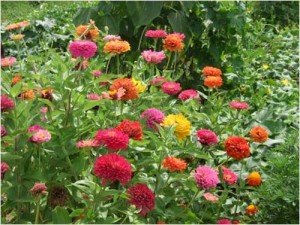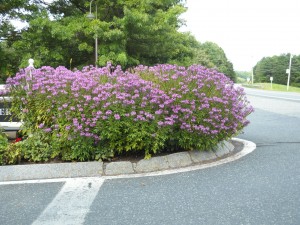Starting Flowers by Seed: Now is a Good Time
Imagine this: you walk into your house and everywhere you turn there are vases full of gorgeous, colorful flowers. Light green zinnias on the kitchen counter, pink and white cosmos on the hall table, blue bachelor buttons in a crystal vase on the dining room table. In fact, imagine every flat surface in the house with a vase filled with flowers. You can do that. Start planting annual flower seeds now and it can be a reality sooner than you think – annuals are fast growing.
You don’t have to spend a fortune at the local garden center buying plants in June. Start annuals now and tend them for 6-8weeks indoors. Plant them in full sun once frost has departed for the summer and ground is warm. Water lightly, whisper a few kind words to them, and keep the weeds down. They will reward you handsomely.
Easy-to-start flowers include cosmos, zinnias, annual bachelor buttons, and marigolds, among others. You’ll need some lights to grow them well indoors until summer. I use 4-foot fluorescent shop lights that I hang just 6 inches over their tops. If you grow them without lights they tend to get long and leggy. I suppose you could carry them outside every day and bring them in at night, but the mornings here are still pretty cold. It should be 50 outside before you take them out.
Some annual flowers are best started outdoors. Sweet peas are lovely, usually fragrant flowers that can be started outside as early as regular eating peas – anywhere from mid-April forward. Before planting the seeds soak them for 24 hours to hasten germination: otherwise they can take up to a month to germinate, leading some people to give up on them. And if you wish to start some indoors, know that they need cool temperatures to germinate, so do not use a heat mat.
The usual method for planting peas is to work some compost into the soil and create a furrow 2 inches deep. Plant the seeds 3-4 inches apart and an inch deep. As they grow, you can then fill in the furrow around the plants. Most sweet peas will need a trellis or fence to attach themselves to. One way to do that is to use the branches pruned off your apple trees – just poke them into the soil and let the vines climb up. Chicken wire or bamboo stakes will also work.
Another cold-loving annual is larkspur, which is also called the annual delphinium. It needs cold soil to germinate and hates to be transplanted, so I recommend planting it directly in the soil – which you can do now. Sprinkle seeds on the soil surface and cover with a quarter-inch or less of fine soil. I often use an old sieve or colander to shake sifted soil over seeds needing a thin cover. Once seedlings are up you will need to thin out the plants. If you want masses of plants, thin to 6-9 inches, and they will stay relatively short. If you thin to 12-18 inches they will grow taller, particularly if you select tall cultivars. And plant seeds in a pattern so when they start to grow you will know they are not weeds!
If you have gotten discouraged with perennial lupines because they get loaded with aphids and the leaves turn brown and ugly by mid-summer, think about growing annual lupines. I never have, but am currently looking for seeds. The species that sounds best is Lupinus hartwegii. It comes in an array of colors including blue, pinks, white and gold. But it is not for everybody. It takes2-3 weeks to germinate, and the seeds need to be soaked in warm water (in a thermos) for 24 hours, or nicked with fingernail clippers. I am looking locally for seeds, but have also found the seeds on-line at http://www.swallowtailgardenseeds.com .
Once the soil warms up and frost is past, you can plant nasturtiums and sunflowers directly in the soil. But be advised that sunflowers don’t always point their faces where you want them to. They face the sun, which may be away from you. So I suggest putting them next to the barn or house. That way they will always be looking outward toward the light. They now come in an incredible variety of colors and heights, and may have several flowers on a single stem.
Most annuals don’t need rich soil or lots of nitrogen. In fact, cosmos, cleome and nasturtiums are notorious for growing tall (or long) with lots of leaves but no flowers until late in the summer if given fertilizer. On the other hand, some modern varieties of petunias and verbenas planted in containers really do need regular fertilizing to keep them pumping out the blossoms.
One last bit of advice: despite what you were told in kindergarten, pinching is good. Pinching almost any annual (or using scissors to snip off the top) when it is 3-4 inches tall will encourage it to be bushier, producing multiple stems. Cut just above a bud or leaf.
I admit that I still spend a fair bit on annuals at garden centers each spring. I can’t start every annual I want indoors – my time and space are limited, and I devote more to my tomatoes and other veggies than to flowers.
Henry Homeyer is a gardening consultant, designer and author. His Web site is www.Gardening-Guy.com. Reach him by e-mail at henry.homeyer@comcast.net.




